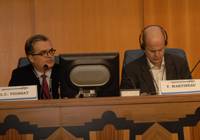
(from left) Ambassador Louis Charles Viossat; Tim Martineau, UNAIDS Director of the Technical and Operational Support Division.
Credit: UNAIDS/Mamadou Gomis
Assessing what really works in the AIDS response, and understanding how it works, is all the more pressing in the current context of global financial slowdown said experts at an ICASA session on Friday.
"The current economic downturn leads us to redouble our efforts and look carefully at the effectiveness of programmes and whether or not they are delivering the results we want," stressed Tim Martineau, UNAIDS Director of the Technical and Operational Support Division.
The event, “Public private partnerships against HIV: how can we together turn the tide?” was organized by UNAIDS as part of the conference’s Leadership Programme. Ambassador Louis Charles Viossat chaired a discussion with panelists who included representatives from the Nigerian Business Coalition Against AIDS, Versteergard Frandsen, the Cameroon Business Coalition against AIDS and the United Nations Economic Commission for Africa.
The event explored the benefits and challenges of public-private partnerships in the global response to AIDS.
A public-private partnership (PPP) is defined as an “institutional relationship between the state and the private profit and/or the private non-profit sector, where the different public and private actors jointly participate in defining the objectives, methods and implementation of an agreement of cooperation”. They are characterized by the sharing of common objectives, as well as risks and rewards.
For governments, PPPs can be an opportunity to harness experience in areas where they lack expertise, as well logistical efficiencies that enable better delivery of prevention and treatment services, reducing costs.
For the private sector (profit and non-profit), PPPs may mean a gain in business opportunities, and an enhanced social and economic environment to operate in.
Participants were agreed that attention should be paid to ensure wide participation and representation across the private sector including from the labour unions, employers’ federations, small and medium enterprises and the informal sector. While progress has been seen, there is still a lot to do to improve participation by small and medium enterprises and the informal sector which employ most of the labour force in Africa.
The group identified four factors as critical in creating and sustaining successful PPPs:
- Clear definition of partners’ roles and responsibilities
- Transparency and respect for ethical standards
- Coordination between partners
- Periodic assessments of the partnership
For Ambassador Louis Charles Viossat, "public-private partnerships have proved to be effective and a way forward to better respond to AIDS. However, we need to acknowledge that they are not a silver bullet.”
“Training, information, periodic assessment of the partnership and application of ethical standards are all important," he continued.
Innovation was stressed as a key factor for any public-private partnership to be successful. Navneet Garg, Global Business Manager from Danish company Versteergard Frandsen, "The Millennium Development Goals (MDGs) of stopping the transmission of HIV by 2015 can only be met by using innovative approaches which facilitate rapid scale-up targeting one and all. Public and private partners should utilize their respective strengths and enhance their partnership accordingly. The enormous challenge needs both partners to step up to achieve what is needed to meet the MDGs".




 (from left) Ambassador Louis Charles Viossat; Tim Martineau, UNAIDS Director of the Technical and Operational Support Division.
(from left) Ambassador Louis Charles Viossat; Tim Martineau, UNAIDS Director of the Technical and Operational Support Division.